|
Monday, October 15, 2012
Progress Notes
This week I am going to feature the stories of some more of those Miller County ancestors who were thought important enough that the museum staff placed their portraits on display in our museum. First I will review the story of the Piles family who lived in the Jim Henry Township south of Mary’s Home near the Osage River and across the river from the Capps area on the other side of the river. A ferry once existed on the Osage River which crossed between Capps and where the Piles family lived on the other side of the river. You can read more about the historical area of Capps at this location on our website.
The photos we have of members of the Piles family are incomplete; however what we do have on our wall in the library area are Firba Piles Abbott (Abbett), her husband William Abbott (Abbett), and their daughter Olive Abbott (Abbett) (photos 01, 02 and 03).

01 Firba Piles Abbott, Wife of William Abbott - 1857-1949
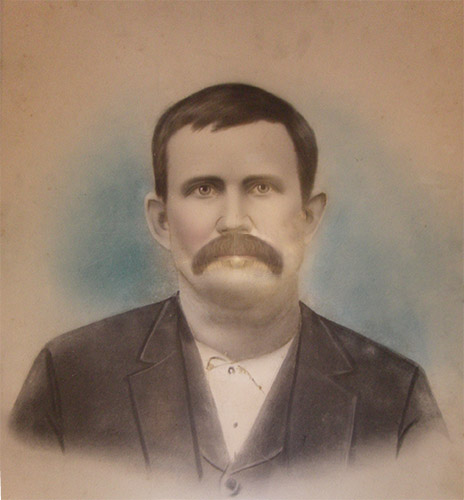
02 William Roundtree Abbott - 1860-1931
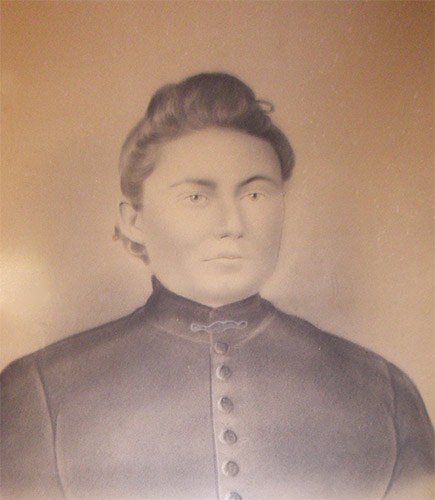
03 Olive Abbott, Daughter of William Abbott - 1886-1949
Once in a while a variation of the spelling of the family name Piles is Pyles. Also, Abbott sometimes is spelled Abbett; however, I believe the original spelling was Abbott when the family first arrived in Miller County.
Peggy Hake researched and wrote the story of the Piles family which I will copy here:
THE PILES FAMILY
James Carroll Piles was born in 1828 in Illinois (per census records). I have not been able to find a record of his father, but believe his mother was Elizabeth Piles, who was living in the home of her daughter and son-in-law, Edmund and Mary Ann (Piles) Riggs, during the Miller County census of 1850. They were living in Jim Henry Township near the Osage River and some of their neighbors were the families of Berry, Musick, Newton, Wood, Van Hooser, Farley and Witten.
James Carroll was one of several children born to his parents including:
- MARY ANN PILES b. 1826 m. Edmund Riggs 1844
- JAMES CARROLL PILES b. 1828 m. (1) Emily J. Berry 1857
- (2) Caroline Brazier (1881)
- JOSHUA W. PILES b. 1834 m. Susan_______
- PHOEBE/FERBA PILES b. 1836 m. (no record)
- FERDINAND PILES b. 1837 m. (no record).
During the census of 1860, James C. (called Carroll) and Emily Piles were living in Camden County, MO in Russell Township. Their post office was listed as Mack's Creek. His mother, Elizabeth, had also moved to Camden County and was living with her son, Joshua Piles, during the same census.
By 1870, Carroll and Emily were back in Jim Henry Township of Miller County and were parents of 8 children:
- PHOEBE (called Ferba) PILES b. c/1857 m. William R. Abbett
- ALICE PILES b. c/1858 m. _____Messersmith
- CALVIN J. PILES b. c/1861 m. (no record)
- JOHN W. (called Jay) PILES b. c/1863 m. Rena Henley
- MARY ANN PILES b. c/1865 m. (1) Frank Fancher
- (2) Francis Abbett
- WILLIS PILES b. c/1868 (never married) and his twin brother,
- PORTER P. PILES m. Belle Wilson; and CHARLES PILES 1870-1870.
Emily J. (Berry) Piles died in 1876 at the age of 40 years leaving Carroll with several young children still home. He married Caroline Brazier in 1881 and was only married a short while before his death in 1882. He was buried beside his first wife, Emily, in the Berry Family Cemetery which is located today on the Bernard Schwaller farm, north of the Osage River in Jim Henry township.
By 1900, Jay and Willis Piles, sons of Carroll and Emily, were living in the Old Capps area where they owned and operated a general store called "Piles Brothers General Mercantile". They were also one of Miller County's largest early buyers and sellers of railroad ties, which was a booming business along the Osage. Some of their neighbors in the Old Capps community were the families of McDonald, Stark, Fancher, Lee, Burton, Brown, Atkinson, and Gray.
While reading old Autogram newspapers, I had often read of the Piles Brothers general store, but didn't really know anything about the family. I found a notice of the death of Willis Piles (spelled Pyles in his obituary), who had died in Rolla, MO in March 1953. It said he was a son of Mr. and Mrs. Carroll Pyles who formerly resided on a farm near Marys Home and he was survived by a brother, Porter Pyles of Arkansas, several nieces and nephews from the Abbett family of Tuscumbia. It also stated "in the late 1800s and early 1900s, he was engaged with his brother, the late Jay Pyles, in a general merchandising business at Capps." With this bit of information, I thought perhaps a story about the Piles family might be of interest to some in the Old Capps/Marys Home area.
I found an interesting item in the Miller County Autogram, dated 8 Feb 1900 ....."CAPPS NEWS...We had musical entertainment at the Piles Brothers in Capps last Friday night and we much regret the report is out that our social ended in a 'shindig'. We hardly think this name applicable to the occasion.".............According to Webster's Dictionary, a shindig is a folksy term that was described as a dance or any social affair or party or merrymaking or noisy disturbance or commotion...........To me, it sounds like they were just having a good time!
On the same museum wall as the Abbott-Piles family photos is a portrait of a man which is titled W. “Pink” Berry 1865-1945 (photo 04).
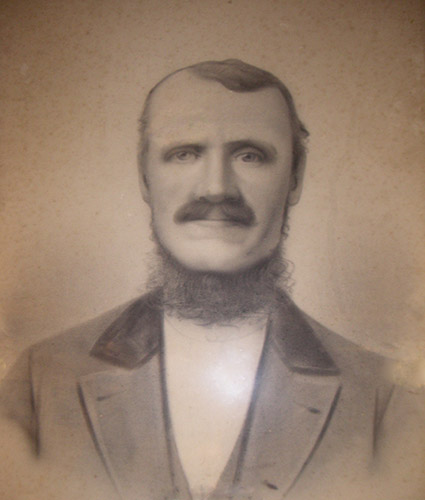
04 William P. Berry
This is another person about whom I knew little. However, since his portrait was placed near the Abbott-Piles photos I figured he must have something to do with them or with the Capps area. As an aside one thing I have learned dabbling with genealogies of our ancestors is that the name “Pinkney” used to be common, and often was abbreviated to the word “Pink.” At any rate I found the obituary for “Pink” Berry which is copied here:
Obituary: Unknown Publication, December 1945
Funeral services were held Sunday, December 9, at the Eldon Baptist Church at 1:30 o’clock for William Pinkney Berry who died at Latham Sanitarium at California, Mo., Thursday, December 6. He was over 80 years of age. Rev. J.E. Brown conducted the service at the church. Burial was in Eldon Cemetery, directed by Phillips funeral Service. Masonic rites at the graveside were conducted by Ionia Lodge No. 381, George H. Catron, Worshipful Master, and Robert E. Reeves, Chaplain. Pallbearers were: S.E. Gunn, Wyatt E. Hill, Howard L. Stephens, Dr. W.H. Brockman, Alex G. Darrall, and Walter S. Reed.
William Pinkney Berry was born near the mouth of Sugar Creek on the north side of the Osage River, March 24, 1865. His parents were Calvin J. and Sarah Ann Berry. He moved with his parents to a farm on Humphreys Creek near Capps, Mo., about 1870. He was married to Mollie Burris of Tuscumbia, Mo., in 1886. They lived on the Hickey farm near Tuscumbia for about 9 years. Then they moved to Eldon, where Mr. Berry was engaged in the feed and livery business for many years before his retirement. His wife died in 1932.
Mr. Berry was a member of the First Baptist Church of Eldon. Just recently Mr. Berry had received a pin from the Masonic and Odd Fellow Lodge for fifty years membership. He was active in both Orders as long as his health permitted. He is survived by two sisters, Mrs. Albert Meredith of Iberia, Mo., and Mrs. Clayton Bilyeu of Granite City, Ill.
So it appears from the obituary that Willliam Pinkney Berry was born on the north side of the Osage River just across the river from the Capps area which was located on the south side of the river. I did some research and found this brief lineage of William Pinkney Berry:
Joseph Berry b. 1750 Va.; d.1812 Va.
Thomas Berry b. 1773 Va.; d.1850 Tenn.
Phillip Berry b.1805 Va.; d.1855 Miller Co.
Calvin Berry b.1831 Ky or Tenn.; d.1919 Miller Co.
William Berry b.1865 Mo.; d.1945 Miller Co
At this point I asked Peggy Hake if she knew about any of the Berry family living on the north side of the river (because the obituary reported “Pink” was born on the north side of the river before moving south to the Capps area with his parents) and this is her response:
Joe,
There is a possibility Pinkney Berry was part of a Berry family who came from around Claiborne Co., Tennessee and settled north of the Osage near present day Mary’s Home in the early 19th century. I know of a member of my Jenkins ancestral family who married a Berry back in Claiborne (Rachel Jenkins Berry). They came to Miller County with some of the Jenkins clan. If I remember correctly there is an old cemetery south of Marys Home high on a hill overlooking the Osage which is named Berry Cemetery. It was unkempt and not known about for many years but a fellow out east (I think he may have lived in Virginia but I can't remember his name) had it cleaned up a few years ago. It might be located on the Bernard Schwaller farm so you could check that out to see if anyone in that area knows about the old cemetery.
Peggy
So to follow up on what Peggy knew I asked our museum director, Karen Smith, if she knew about a Berry Cemetery on Bernard Schwaller’s farm. Karen knows Mr. Schwaller and confirmed with him indeed a Berry cemetery is present although it is located high on a hill overlooking the river and requires walking over some rough terrain. Not too long after I talked with Karen, Peggy wrote me back:
Joe,
I found information on the Internet which mentions a Berry Cemetery on the farm of Bernard Schwaller, once owned by PHILLIP BERRY.
Peggy
As I listed above in Pink Berry’s descendency, Phillip Berry was William Pinkney Berry’s grandfather; so although Pink Berry’s family moved south of the river to Capps, his Berry predecessors had settled near the farm north of the river across from Capps now owned by Bernard Schwaller. The Internet site cited by Peggy has some interesting gossip about Pink Berry’s grandfather, Phillip, which I will copy here:
The elusive Phillip Hawkins Berry is a very interesting character. He was born in 1805 in Va. and migrated to Claiborne County East Tennessee. The Berry family came into Claiborne Co. from Virginia, probably Washington County, just over the line and a bit East of Cumberland Gap. It is believed that they had migrated down the Shenandoah Valley along the Wilderness Road to the Saltville are of Washington Co., VA. from the Martinsburg area of Frederick Co., VA., later West Virginia.
Claiborne County is very beautiful with its winding back roads, steep wooded ridges and limestone faced mountains. The Cumberland Gap makes up the East border.
The story of OVERMOUNTAIN MEN at the Battle of King's Mountain is very much connected to the settlers of this area. From John Simeon Hurst Jr. aforementioned book, "The people of East Tennessee first distinguished themselves as fighters during the Rev. War when the English in NC sent word across the Great Smokies for the overmountain men to come over and join up or we will come and burn your crops and homes. They promptly went, but did not join the British, but blitzkreiged them. They then hurried back to fight off the Indians. Military rosters of the men who fought at Kings Mountain include Thomas Berry, possibly father or grand father of Phillip.
There is no census record for Claiborne Co. before 1830 and no marriage records before 1838, so relationships are difficult to prove. On the 1839 tax list of Claiborne Co Thomas Berry owned 100 acres of deeded land valued at $50. He lived in Dist. 9, the Tazewell Dist. This would put their property south of Powell River and West of the Ky. Road.
The Claiborne County Court records for 1827-29 show that Phillip got himself into a bit of a predicament. He apparently fathered a child by Polly Jenkins, apparently a daughter of Thomas Jenkins who brought the case and provided $250 security. Thomas Jenkins is presumed to be Polly’s father , but this is not proved. One would assume he was expecting Phillip to marry Polly, but no marriage records are available for this time in Claiborne Co. Thomas Berry, father of Phillip was also charged. Phillip was ordered to pay $450 for the care of the child. The case drew to a close in June of 1829 and Phillip was never documented in Claiborne Co. again. There are many possibilities, but no proofs here. No further mention has been found of Polly. Maybe she died or maybe she was the lone Mary Berry 20-30 on the 1830 Tn. census for Claiborne Co. with one son under 5 in the home. One would think this might be Polly, and that Phillip Berry had gone to Mo. to prepare a home for them. He has not been found on any census for 1830. Maybe Phillip was already married. On the 1850 census two sons in his first family were born before 1830: Jaconias, born about 1827 and Sterling, born about 1828. Jaconias then disappears from Mo. records. Maybe Mary used the name Berry on 1830 census, but was not actually married to Phillip. Or, maybe Polly married someone else. A final possibility is that Phillip married Polly Jenkins but they divorced. A book of early Tennessee divorces shows no such record . If Polly survived, it is likely she came to Mo. It is possible that she was the first wife of Israel Newton or John J. Denton, but research has not disclosed this. These families were close, and John J. Denton administered the estate of James A. Jenkins. There is also a possibility that James A. Jenkins who died young may have been the child of Polly. I believe he was raised in the home of Thomas Jenkins. I don't know if he was a son or grandson. One genealogy shows him as Thomas' son. He lived next door to Phillip Berry in 1850. I presume Phillip went to Ill. where he entered land recorded in Marion Co.
The Pre-Emption Acts of 1830 and 1841 are probably what encouraged the Berry-Piles --Jenkins families to move to Missouri.
There are 3 Public Land Purchases in Marion Co. Illinois by Phillip Berry about 1840. He apparently did not settle on these; I do have documentation of them. Phillip married his second wife Rachel Jenkins on January 31, 1841 in Miller Co.
Phillip Berry died in 1855 before he saw the Civil War tear families and friends apart. His children and second wife Rachel did not escape this terrible time. From Judge Jenkins HISTORY OF MILLER COUNTY MISSOURI v2 we learn of some of the tragedy Rachel endured during her long life. In Feb of 1866, the men folk were away, and her daughter Nancy A. Stepp was living with her.
Rachel went out to the spring to get water, and her younger children were playing behind the house when bushwhackers rode up. They entered the house and shot Nancy who fell dead. They then shot son Edmond in the chest. The younger children ran away into the woods, when Rachel returned, the house was ablaze, and she thought all her children were dead. Several days later neighbors found the two youngest children, John W. and Mary E. in the woods, half naked and almost starved. (Jenkins V2 p 20)
Rachel lived to be nearly 100 years old.
I want to give credit to Gaynelle Jenkins and her book THE JENKINS FAMILY OF CLAIBORNE CO., TENN. AND MILLER CO. MO. for much of my information.
I don’t know for sure if the Eldon descendents of William Pinkney Berry knew anything about the story of William’s grandfather, Phillip Berry. But it serves to remind us just how terribly hard life must have been back then, especially considering that once here the settlers from back east not only had to worry about shelter and feeding themselves but also had to contend with Civil War bushwhackers!
One old photo which was donated to us was of a traveling salesman of long ago who represented the the Rawlings Company which sold herbs and patented medicines throughout the Midwest (photo 05).
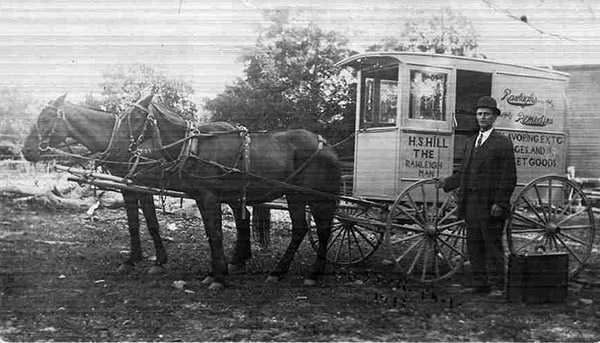
05 Traveling Medicine Man
We don’t know anything about the gentleman in the photo nor where his supply house was located. However, the Rawlings company has existed since the late 1800’s and in fact is still operating today. I did some research and located the following information:
Return of the Rawleigh Man (photo 06)
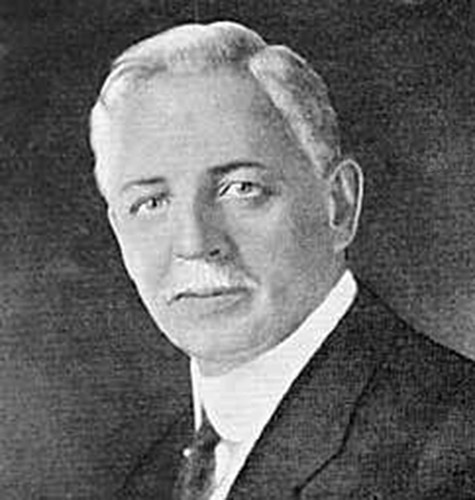
06 W.T. Rawleigh
Generations of Australians, Canadians and Americans grew up waiting for The Rawleigh Man to arrive at their front door with his sample case of goodies to add spice to their life and to heal their ailments.
The Rawleigh Man brought to family front doors the best materials money could buy from around the world: spices from Sumatra, Java, China, India, Africa, the West Indies; black pepper from the island of Ponapai; lemon and orange oils from California and Sicily and Vanilla from Madagascar and Java; high grade coffee beans from the Andes.
Most of the herbs, roots, barks and buds used in making cough medicines and tonics came from Europe, India, Ceylon, China, North America, the West Indies, Jamaica, Honduras and Asia. From Japan came camphor and menthol for making medicines. From Tavenui, the Garden Island of Fiji, came the food grade coconut oil for Rawleigh's gold medal winning Coconut Oil Soap.
In April 1889, against his father's wishes, 18-year-old Will Rawleigh set out to make his fortune selling medicines door to door with a mortgaged buggy, an old blind horse named Bill and a rig on time payment.
Within three years, he had paid for a good horse and a new wagon, all his freight and living expenses, bought a new home and furnished it and had several good rigs and everything needed with which to conduct his business. His net worth at the end of his third year would have been about $5,000 - a fortune back in 1892.
"From poverty to prosperity are the words which seem best to describe my first three years," he later wrote.
Rawleigh worked hard at his business but it took a huge toll on his health and in 1916 he was admitted to the famous Battle Creek Sanatorium of Michigan. It was there that he developed his health philosophy of prevention is better than cure and amid ridicule and scorn, launched research into vitamin supplementation and healthy living.
W.T. later wrote: "During the latter part of 1916 my health became impaired. I was nervous and run down and I had a well defined case of anti-intoxication caused by a lack of knowledge of proper foods, constant work indoors, lack of sufficient fresh air and exercise and the constant strain of business had all so impaired my strength that I was compelled temporarily to give up work."
He experienced a miraculous recovery aided by the institution's philosophy of "Back to Nature."
At the conclusion of his time at the sanatorium he made the following commitment: "Gratefulness for my own recovery from a very serious condition brought about by my own lack of knowledge of healthful living and thankfulness for the teaching, which not only enabled him to recover, but to keep well and efficient, and in appreciation of what knowledge of maintaining health may mean to many people, resulted in his decision to reach out and help educate the great masses of people who have neither the time nor the money for sanatorium special treatment, and give them the benefit of what he had received."
Rawleigh's registered medicines were used extensively in the days before antibiotics were invented and doctors were few and far between. Families learned to rely on Rawleigh's medicines in emergencies to relieve sickness, pains and injuries. In World War II, most Australian soldiers posted overseas carried a tin of Rawleigh Antiseptic Salve in their kits to treat wounds and ward off infection.
By 1920, young Rawleigh had built the biggest manufacturing organization in the world and at one stage had more than 500,000 kgs of pepper and 38 tons of vanilla beans in stored in fire proof vaults in his seven factories.
Mr. Floyd George Rawleigh who was the son of David Rawleigh, W.T.Rawleigh's brother, came to Australia, with Mr Jackson, in 1931 and set up the Rawleighs Company business there . Mr. Floyd George Rawleigh stayed on in New Zealand, in the Company, married here and had 4 children. He never went back to the States, to live, except for visits, to see his family there. When Mr. Floyd Rawleigh died in Feb 1980 his ashes were sent back to the Rawleigh Family Cemetery in Freeport, where W.T. Rawleigh was buried.
Bev Rawleigh married one of the Sons, Wilbour Terrence Rawleigh, born Feb 1936 who was named by W.T. Rawleigh the Founder after his only son died in the war, W.T. Rawleigh was the Bill Gates of his time. A great man.
Rawleigh products are still only available from Rawleigh men and women who carry on the time-honoured tradition of the Rawleigh company to give individuals a go at developing their own business supplying products to people in their homes.
Only now they are also doing it in cyberspace.
I know that traveling salesmen went from town to town many years ago in their horse drawn wagons which were painted with bright colors advertising many medicinal products. My mother who now is nearing 91 years old recalled seeing them come through Tuscumbia once in a while. According to the above website, the Rawleigh company now is modernized and distributes products world wide.
Another of the interesting items we found in the Walter Stillwell trunk which was donated to us by his grandson, Raymond Stillwell of Alton, Illinois, was an invitation to a “Sock Social” sponsored by the Tuscumbia Christian Church (photo 07).
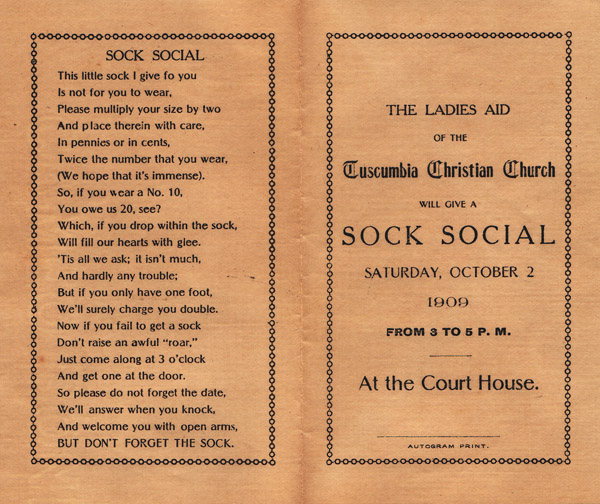
07 Sock Social - 1909
Now I must say that I had never heard of a “Sock Social” so I searched the internet and found that early on back in the late 1800’s and early 1900’s the “Sock Social” was a means of raising money for a worthwhile cause. In all the invitations I found on the internet which were sent in that earlier time frame, the wording of the invitations was quite similar to the one from the Tuscumbia Christian Church with only a few word changes. However, in recent years a “Sock Social” isn’t necessarily restricted to a charity event; in fact, one invitation I saw on the internet was sent by a ladies knitting group which was actually knitting socks!
We have access to an internet service which daily tracks where are located those readers who access our Miller County Museum website. The website not only tabulates all those who visit our website daily but also adds a graph which is structured to give a representative sample of the distribution of visitors. I was surprised somewhat to learn that our site attracts readers from all across the nation. Several times each week we also will have one or two visitors from foreign countries, usually Great Britain or mainland Europe. Here is a map of the daily visitors to the site a couple of weeks ago (photo 08):
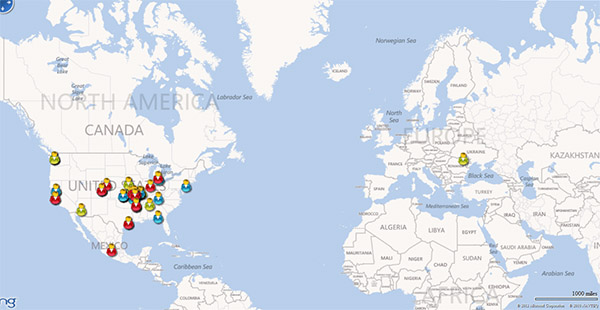
08 Website Visitor Map
You will observe that one reader was from Mexico and another from eastern Europe. The tracking service indicated that the reader from eastern Europe was from the country of Moldova! I have to admit I didn’t know about this small eastern European country. After reading about it on Wikipedia I found it has a very interesting history which you can read for yourself at their website.
Could the reader from Moldova have accessed us by accident? Or maybe someone long ago once lived in Miller County who was a Moldovian?
Last Saturday (October 13) the annual Tuscumbia High School Reunion was attended by several hundred alumni who enjoyed a superb supper and program under the direction of Alumni president, Larry Flaugher. The highlight of the evening was the presence of Tuscumbia alumnus, Derrick Helton, who is internationally known as being one of the world’s greatest competitors in the sport of wheel chair rugby Here are a couple of photos of Derrick, one with his grandmother, Arlene Lupardus, and the other with me (photos 09 and 10).
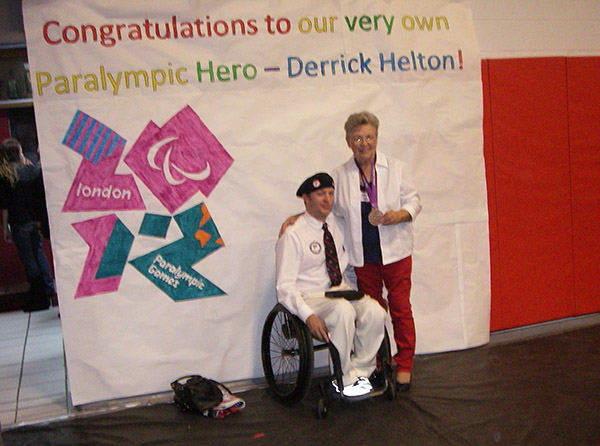
09 Derrick Helton with Grandmother Arlene Helton
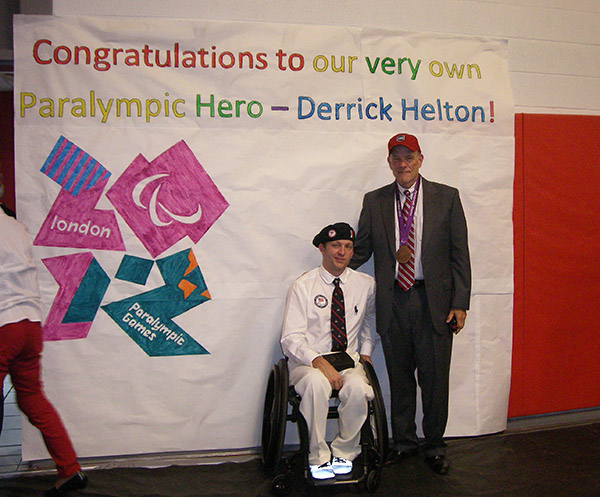
10 Derrick Helton with Joe Pryor
The award hanging from my neck was the one Derrick won in the Olympics; and the cap on my head which has the Olympics logo was the one Derrick was given by the Olympics. Derrick was a victim of neurofibromatosis, a disease in which fibrotic nodules spontaneously develop in motor nerves throughout the body causing muscle atrophy and weakness. However, his remarkable courage and will power have enabled him to become independent for activities of daily living from a wheel chair and even participate in the highly physical, risky sport of playing rugby. Here are some photos of Derrick training and playing rugby (photos 11 - 16):

11 Derrick Helton

12 Derrick Helton
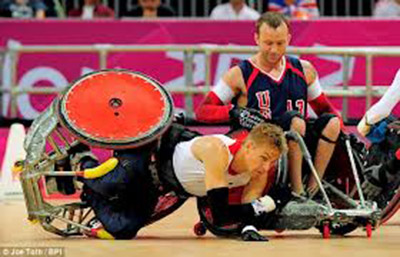
13 Derrick Helton

14 Derrick Helton
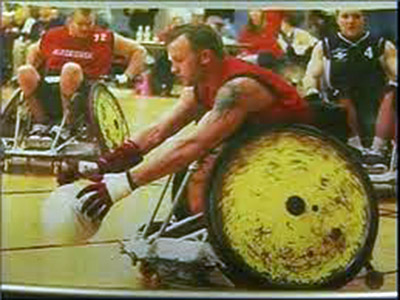
15 Derrick Helton
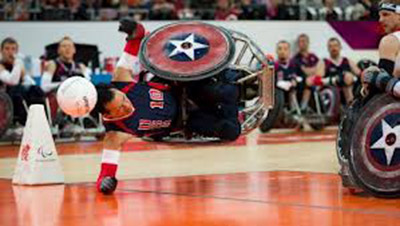
16 Derrick Helton
Derrick’s presentation to the alumni audience included videos of himself playing rugby and a short narrative about the game. The Lake Sun newspaper recently presented a very interesting write up about Derrick which is presented here:
Leaving a Lake Legacy: Tuscumbia native playing in 2012 Paralympics games
Derrick Helton 'makes a killing' on murderball, quad rugby court nationally, internationally
By Samantha Edmondson
In seven years, Derrick Helton has diligently showcased his skill of “murderball,” also known as quadriplegic rugby, courts across the globe now landing him an opportunity to achieve one of his largest goals – play in the 2012 Paralympics.
This top-level competition is part of the upcoming London Summer Olympics Games and will follow those events with games starting Sept. 3. When the 26-year-old Tuscumbia native wheels onto that court as part of the selected USA team, he hopes to defend the world and Paralympics champion title along with his 12 teammates.
“This has been a dream of mine for a long time now, at least four or five years,” said Helton. “I got the opportunity to go to the 2008 and was first alternate for the Beijing Olympics. However, no one got sick or couldn’t go, so I didn’t get to. However, I was not going to miss the next chance. Now, I am on the team. We have a about half new players, and half old players, ranging in all ages. We have a lot of experienced players and a lot of speed. We are pretty well set, and are eager to compete and win.”
For Helton, his experience derives from playing on teams under the U.S. Quad Rugby Association, recruited to play for the University of Arizona Wildcats quad team for many years, helping to start and play on the Tucson Pterodactyls quad rugby club team, which is also part of the U.S. Quad Rugby Association, and playing for the U.S. National team.
The Paralympics is a competitive opportunity for physical, mental and emotional growth that Helton would not have come by without the fruition of his ailment neurofibromatosis shortly after high school graduation, discovery of murderball while in Missouri and loving support of his family, his friends and fellow players, and his now his biggest fan, his wife, Krista. For Helton, it is a personal ambition that has come quickly, lived out presently and fulfilled in accomplishments that will last for a lifetime.
Coming to court
At Miller County R-III High School in Tuscumbia, Helton was an athlete, a national science symposium award-winner and a well-liked, well-respected young student and man. According to his grandmother, Arlene Helton, he missed his graduation and senior trip to attend a national science symposium and competition in Portland, Ore., in which he took a high-ranking medal.
Arlene said Helton had noticed some problems with his right hand when playing sports and a few hearing issues. However, Helton was determined to pursue his current goals at the time, wanting to attend college after enlisting in the Marines.
That same summer of 2004 after Helton graduated, he had found out from specialists he had neurofibromatosis, which is a genetic disorder of the nervous system and affects the way nerve cells form and grow. It can be hereditary or mutated, with specialists determining Helton had a mutated form and type 2 of the illness, which tumors grow inside the body.
Following a surgery to remove the five tumors they had found as a result of neurofibromatosis, the procedure ended up landing Helton paralyzed. He had movement in his arms, neck and head. He was transferred to Rusk Rehabilitation Hospital in Columbia for recovery, treatments and therapy. Arlene went to visit her grandson a short time after his arrival and his slowing recovery at the center.
“I was cleaning up some things in his room, and he said to me, ‘Grandma, you know I was thinking how lucky I am.’ I said, ‘Lucky, how are you so lucky?’ He said, “I have the use of my arms. Anyone could have come in here in the middle of the night, put a pillow over my face and I couldn’t have protected myself without the use of my arms.’ My heart just burst,” she said with a half smile. “He started to see people at Rusk that were a lot worse off than he was and really started to turn around from his depression; he has always been determined, but he was realizing that he could still do things he wanted to do.”
After his time at Rusk, he returned home and ended up watching a documentary called, “Murderball,” all about the U.S. Quad Rugby Association and teams. He decided to seek out how he could get involved, and landed himself on a spot as part of the St. Louis Rams club team in 2005. After competing in a tournament in San Diego, Calif., he was signed to join the University of Arizona Wildcats team, where he truly developed his skills on the court.
Honing his skills
Helton took quickly to the game, the team and honing his skills on court. For spectators, like Grandma Arlene, his father, sister and adopted nephew Jude, it is intense to watch.
According to the U.S. Quad Rugby Association, quad rugby is a simple game with complex strategies for playing both offense and defense. It is played with a volleyball on a basketball-size court with goal lines marked by cones and a lined-off “key” area, the website noted.
The object of the game is to score a goal (one point) by crossing the goal line with possession of the ball while the opposing team is defending that goal. The team with the most points when time runs out wins, the website stated.
Quad Rugby is a full contact sport, but no personal contact is allowed such as slapping, hitting, punching, gouging out eyes, biting off ears, etc. and penalties are enforced, usually requiring time in the penalty box, according to the website.
For what is known as the most aggressive of sports as part of the Paralympics, Helton said it takes a lot of physical preparation both in training and in set-up before wheeling into position before the time clock begins.
“Physically, you have to strap your feet in and your hips with special straps. And you are tight in your chair, so you don’t fly out of it in case you get knocked down,” he said, who has been knocked down on the court in past tournaments and game play. “However, what I have learned over the years is the mental aspect of the game. You use your mindset to score points and be effective in the game and for your team. Your mental involvement in the game is just as if not more important than your physical ability.”
For Helton, he has not only seen many championships during his time with the University of Arizona Wildcats quad rugby team, but also as part of the club team, Tucson Pterodactyls. In fact, he is a second-time national championship with his club team and traveled to locations across the country and visits to other countries, as well.
He has also seen a lot of good and strength in the community of Tucson, where he lives and studies at college, through his and his fellow teammates work with their quad rugby team. Plus, he sees a competitive edge on the court for them, as well.
“We average in age in (our early to mid-twenties), where the rest of the club teams are a bit older or varied in age. We have the youngest team in the (association) now and we hit in the right places, too,” he said.
He also knows that some of his memorable moments since starting to play “murderball” is simply playing an old-fashioned pastime quad rugby game with friends – “Bad News Bears” style, as the team starter called it.
“I’ve made close friends through the club team, really some of the best friends I have; they are friends for life,” he said. “You learn so much through this group and know that they really take care of you; we take care of each other.”
Bearing the “rings”
For Helton, his educational studies continue both at school as well, recently changing his degree from teaching to biosystems engineering. Plus, he is excited and supported by his beautiful wife, Krista, a doctor in physical therapy.
Currently he gets to take finals, but also spend some quality time as a newlywed before heading off to a full round of training for the Paralympics, national competitions and additional training in general as part of the U.S. quad rugby team.
“I get a lot of support from Krista. She is so thoughtful, and has truly been a great support through it all,” she said.
In fact, while in Europe for the Paralympics, Helton plans for he and Krista to take a “real” honeymoon touring Ireland and other parts of the continent. Also, his father, who tries to make every major competition, championship and sectional Helton plays in, is trying his hardest to watch him play in the Paralympics. Plus, grandma hopes to go, too. Arlene is just so proud of her grandson and finds just how amazing it is how much she has learned from watching him blossom over the last few years.
“It is amazing what we learn from it. Like him, seeing the people bad off at Rusk, we saw it, too. It gives you a totally different perspective of what is going on their lives, and what is going on in yours,” she said. “But Derrick has always been determined and doesn’t want help with anything. He told me once, ‘Grandma, I know everything there is to know about what I have. I will do just fine.’ He sure is doing just fine, and I’m so proud of him.”
Helton is getting ready for the game, but for him, just attending the Olympics is a dream come true. He is looking forward to the court, he is forward to the experiences, but he is also looking forward to being part of the opening and closing ceremonies.
“For people who have been in the past, they said being out there during the opening ceremony is one of the neatest experiences; I am looking forward to that and being out there with all my fellow Olympians,” he said. “I will also look forward to standing there and hopefully wearing the gold medal, too.”
For more information about the U.S. Quad Rugby Association, visit quadrugby.com.
Certainly, all Miller Countians are proud of native son Derrick Helton who amazingly has achieved the status of being an Olympic champion in the world Paralympics in spite of being afflicted with neurofibromatosis which causes nerve impairment resulting in paralysis of multiple muscle nerves throughout the body.
Plan now to attend the final event of the 2012 season presented by the Miller County Museum scheduled for 11a.m. to 2 p.m. Saturday, Oct. 20, when the annual chili dinner and car show will be presented. A lunch of chili, dessert and drinks will be offered for a charge. Music will be provided by the Joe Jeffries musical group. A classic car show also will be featured, coordinated by Larry Flaugher.
All classic car owners who would want to display their car are invited. The car show is for fun only; no judging or trophies will be given. All cars for show will be parked in the county courthouse parking lot. In the afternoon a drawing for a handmade quilt donated by Elva Steen to the museum will be held (photo 17):
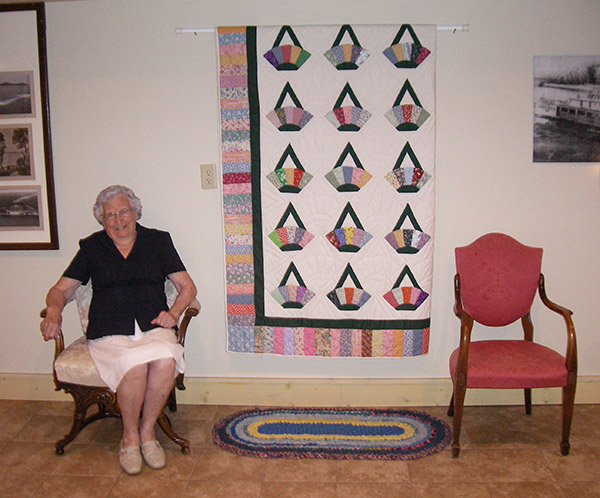
17 Elva Steen with Handmade Quilt
This fall is turning out to be a colorful one. Here are some photos I took on Highway 52 between Tuscumbia and St. Elizabeth of the Osage River which flows below the hills and bluffs above (photos 18, 19 and 20).
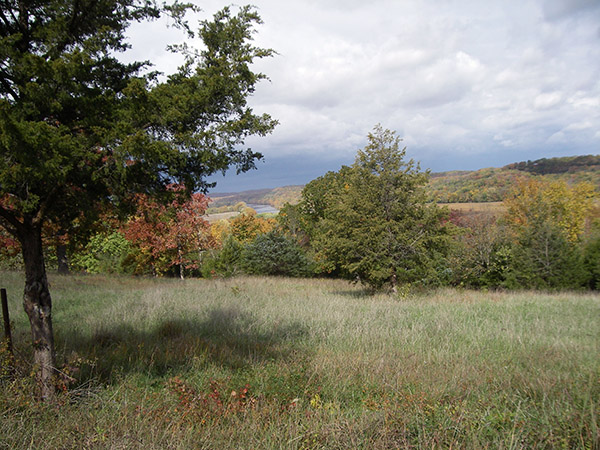
18 Osage River Bluffs

19 Osage River Bluffs
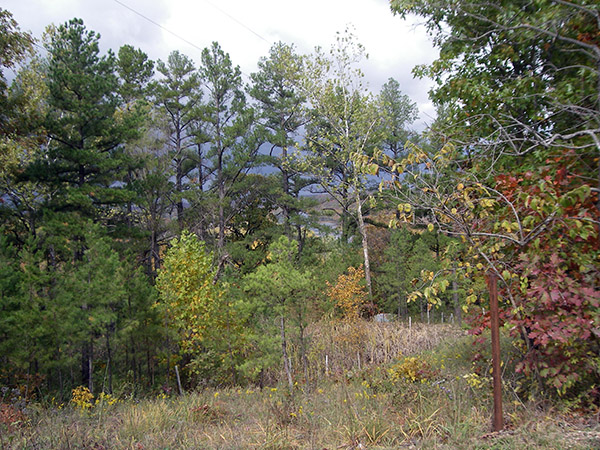
20 Osage River Bluffs
And here is a photo of the hills above the Osage River taken from the Tuscumbia Osage River Bridge (photo 21).
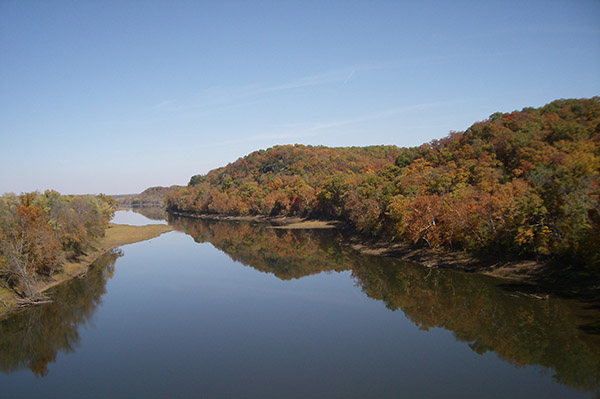
21 Osage River at Tuscumbia
That’s all for this week.
 Joe Pryor
Previous article links are in a dropdown menu at the top of all of the pages.
|

